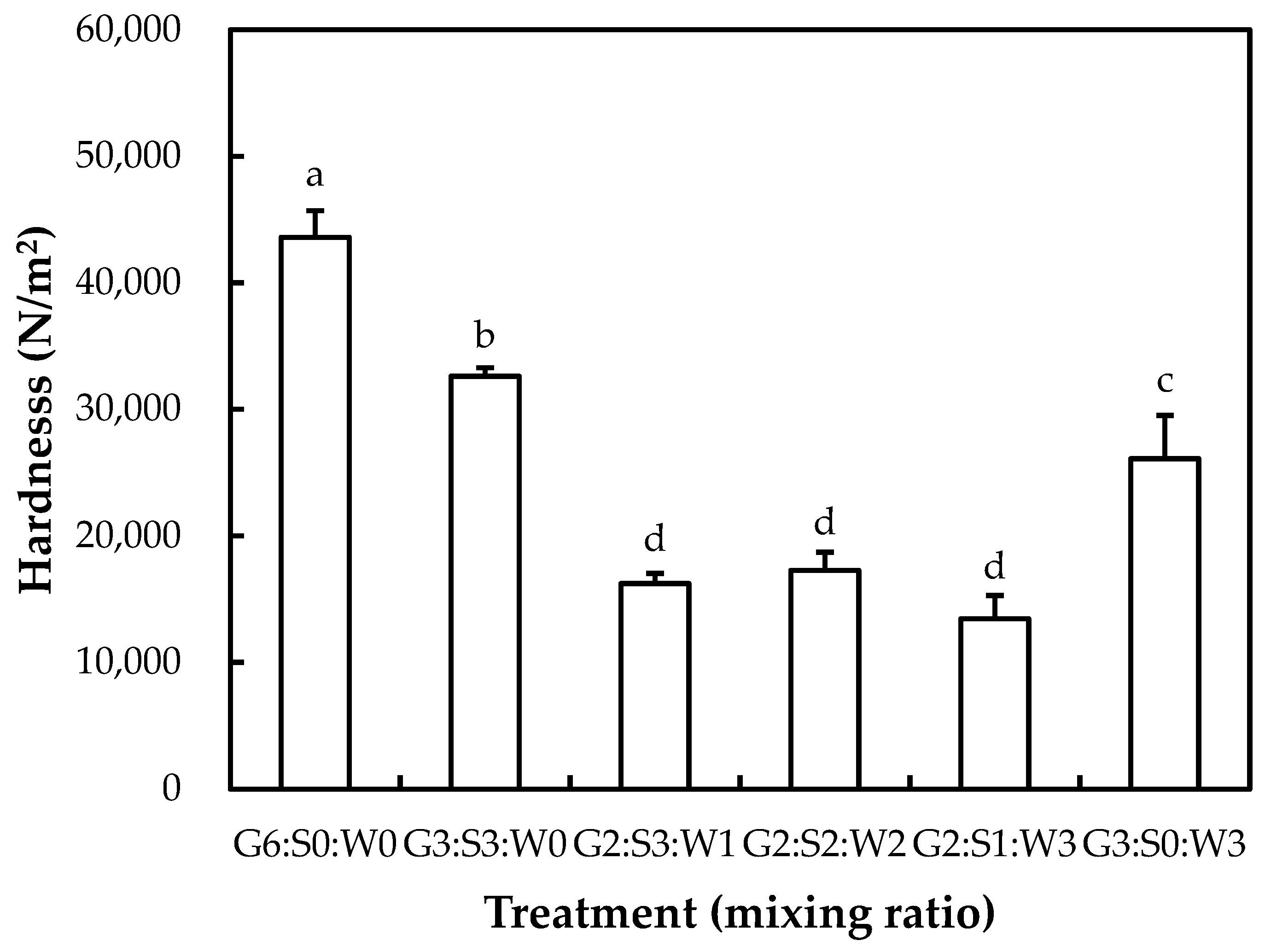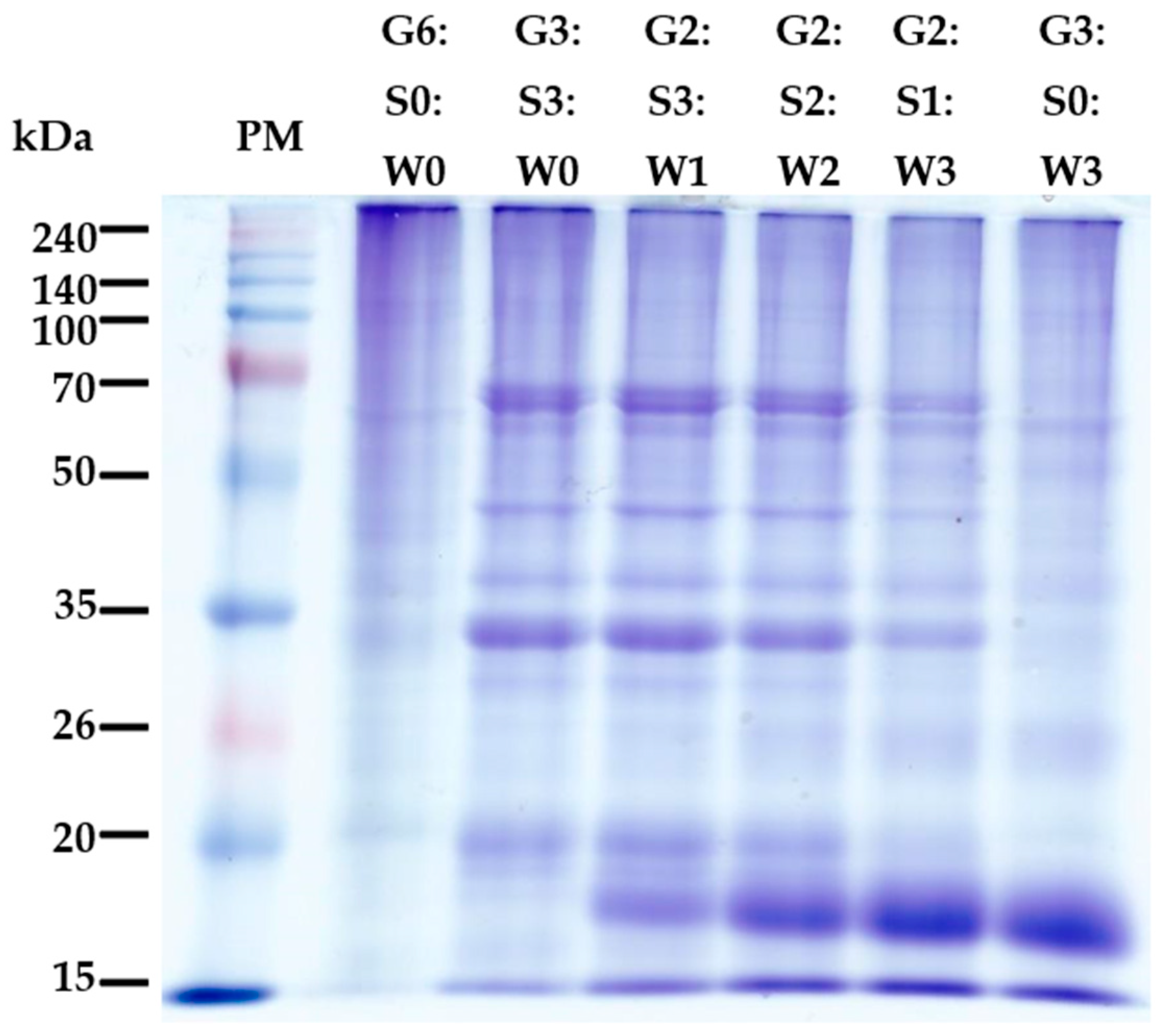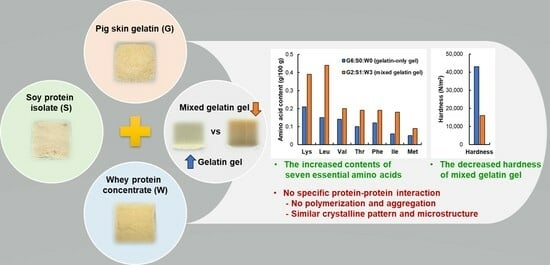Physicochemical Properties of Mixed Gelatin Gels with Soy and Whey Proteins
Abstract
1. Introduction
2. Results and Discussion
2.1. Processing Yield and pH
2.2. Proximate Composition and Calorie Content
2.3. Total Amino Acid
2.4. Hardness
2.5. Protein SDS-PAGE
2.6. X-ray Diffraction (XRD)
2.7. Microstructure
3. Conclusions
4. Materials and Methods
4.1. Raw Materials
4.2. Gel Preparation
4.3. Physicochemical Analysis
4.3.1. Processing Yield
4.3.2. pH
4.3.3. Chemical Composition and Calorie Content
4.3.4. Total Amino Acid Profile
4.3.5. Hardness
4.3.6. Sodium Dodecyl Sulfate Polyacrylamide Gel Electrophoresis (SDS-PAGE)
4.3.7. X-ray Diffraction (XRD) Assay
4.3.8. Microstructure
4.4. Statistical Analysis
Author Contributions
Funding
Data Availability Statement
Conflicts of Interest
References
- Aguilera, J.M.; Park, D.J. Texture-modified foods for the elderly: Status, technology and opportunities. Trends Food Sci. Technol. 2016, 57, 156–164. [Google Scholar] [CrossRef]
- Liu, F.; Yin, J.; Wang, J.; Xu, X. Food for the elderly based on sensory perception: A review. Curr. Res. Nutr. Food Sci. 2022, 5, 1550–1558. [Google Scholar] [CrossRef]
- Noh, S.W.; Song, D.H.; Yang, N.E.; Kim, H.W. Incorporation of soy protein isolate and egg-white protein to improve nutritional value and hardness of gelatin gels for the elderly. Food Biosci. 2023, 53, 102806. [Google Scholar] [CrossRef]
- Gómez-Guillén, M.C.; Giménez, B.; López-Caballero, M.E.; Montero, M.P. Functional and bioactive properties of collagen and gelatin from alternative sources: A review. Food Hydrocol. 2011, 25, 1813–1827. [Google Scholar] [CrossRef]
- Alipal, J.; Mohd Pu’ad, N.A.S.; Lee, T.C.; Nayan, N.H.M.; Sahari, N.; Basri, H.; Idis, M.I.; Abdullah, H.Z. A review of gelatin: Properties, sources, process, applications, and commercialization. Mater. Today Proc. 2021, 42, 240–250. [Google Scholar] [CrossRef]
- Herreman, L.; Nommensen, P.; Pennings, B.; Laus, M.C. Comprehensive overview of the quality of plant- And animal sourced proteins based on the digestible indispensable amino acid score. Food Sci. Nutr. 2020, 8, 5379–5391. [Google Scholar] [CrossRef] [PubMed]
- Nicolai, T. Gelation of food protein-protein mixtures. Adv. Colloid Interface Sci. 2019, 270, 147–164. [Google Scholar] [CrossRef] [PubMed]
- Qin, P.; Wang, T.; Luo, Y. A review on plant-based proteins from soybean: Health benefits and soy product development. J. Agric. Food Res. 2022, 7, 100265. [Google Scholar] [CrossRef]
- Sarbon, N.M.; Badii, F.; Howell, N.K. The effect of chicken skin gelatin and whey protein interactions on rheological and thermal properties. Food Hydrocol. 2015, 45, 83–92. [Google Scholar] [CrossRef]
- Dai, Y.; Zhao, J.; Gao, J.; Deng, Q.; Wan, C.; Li, B.; Zhou, B. Heat- and cold-induced gels of desalted duck egg white/gelatin mixed system: Study on rheological and gel properties. Food Hydrocol. 2021, 121, 107003. [Google Scholar] [CrossRef]
- Cai, L.; Feng, J.; Peng, X.; Regenstein, J.M.; Li, X.; Li, J.; Zhao, W. Effect of egg albumen protein addition on physicochemical properties and nanostructure of gelatin from fish skin. J. Food Sci. Technol. 2016, 53, 4224–4233. [Google Scholar] [CrossRef]
- Pang, Z.; Deeth, H.; Sopade, P.; Sharma, R.; Bansal, N. Rheology, texture and microstructure of gelatin gels with and without milk proteins. Food Hydrocol. 2014, 35, 484–493. [Google Scholar] [CrossRef]
- Gu, T.W.; Song, D.H.; Noh, S.W.; Ham, Y.K.; Kim, H.W. Gel-forming ability and hardness of animal and plant protein gels at various concentrations for developing senior-friendly jelly foods. Korean J. Food Cook. Sci. 2020, 36, 305–312. [Google Scholar] [CrossRef]
- Zhang, L.; Li, Q.; Zhang, W.; Bakalis, S.; Luo, Y.; Lametsch, R. Different source of commercial soy protein isolates: Structural, compositional, and physicochemical characteristics in relation to protein functionalities. Food Chem. 2024, 433, 137315. [Google Scholar] [CrossRef] [PubMed]
- Outinen, M.; Rantamäki, P.; Heino, A. Effect of milk pretreatment on the whey composition and whey powder functionality. J. Food Sci. 2010, 75, E1–E10. [Google Scholar] [CrossRef] [PubMed]
- Park, S.Y.; Kim, H.Y. Effect of wet- and dry-salting with various salt concentrations on pork skin for extraction of gelatin. Food Hydrocol. 2022, 131, 107772. [Google Scholar] [CrossRef]
- Goudie, K.J.; McCreath, S.J.; Parkinson, J.A.; Davidson, C.M.; Liggat, J.J. Investigation of the influence of pH on the properties and morphology of gelatin hydrogels. J. Polym. Sci. 2023, 61, 2316–2332. [Google Scholar] [CrossRef]
- KS H 4897. Seniors Friendly Foods. 2022. Available online: https://standard.go.kr/KSCI/standardIntro/getStandardSearchView.do?menuId=919&topMenuId=502&upperMenuId=503&ksNo=KSH4897&tmprKsNo=KS_H_NEW_2017_1067&reformNo=01_rank.html (accessed on 22 October 2022).
- Ma, Y.; Zeng, X.; Ma, X.; Yang, R.; Zhao, W. A simple and eco-friendly method of gelatin production from bone: One-step biocatalysis. J. Clean. Prod. 2019, 209, 916–926. [Google Scholar] [CrossRef]
- Newberry, C.; Dakin, G. Nutrition and weight management in the elderly. Clin. Geriatr. Med. 2021, 37, 131–140. [Google Scholar] [CrossRef] [PubMed]
- Gallego, M.; Barat, J.M.; Grau, R.; Talens, P. Compositional, structural design and nutritional aspects of texture-modified foods for the elderly. Trends Food Sci. Technol. 2022, 119, 152–163. [Google Scholar] [CrossRef]
- Bihuniak, J.D.; Insogna, K.L. The effects of dietary protein and amino acids on skeletal metabolism. Mol. Cell. Endocrinol. 2015, 410, 78–86. [Google Scholar] [CrossRef] [PubMed]
- Kamei, Y.; Hatazawa, Y.; Uchitomi, R.; Yoshimura, R.; Miura, S. Regulation of skeletal muscle function by amino acids. Nutrients 2020, 12, 261. [Google Scholar] [CrossRef] [PubMed]
- McCann, T.H.; Guyon, L.; Fischer, P.; Day, L. Rheological properties and microstructure of soy-whey protein. Food Hydrocol. 2018, 82, 434–441. [Google Scholar] [CrossRef]
- Nur Azira, T.; Amin, I.; Che Man, Y.B. Differentiation of bovine and porcine gelatins in processed products via sodium dodecyl sulphate-polyacrylamide gel electrophoresis (SDS-PAGE) and principal component analysis (PCA) techniques. Int. Food Res. J. 2012, 19, 1175–1180. [Google Scholar]
- He, J.; Zhang, J.; Xu, Y.; Ma, Y.; Guo, X. The structural and functional differences between three species of fish scale gelatin and pigskin gelatin. Foods 2022, 11, 3960. [Google Scholar] [CrossRef] [PubMed]
- Liu, S.; Zhou, R.; Tian, S.; Gai, J. A study on subunit groups of soybean protein extracts under SDS-PAGE. JAOCS 2007, 84, 793–801. [Google Scholar] [CrossRef]
- Denavi, G.A.; Pérez-Mateos, M.; Añón, M.C.; Montero, P.; Mauri, A.N.; Gómez-Guillén, M.C. Structural and functional properties of soy protein isolate and cod gelatin blend films. Food Hydrocol. 2009, 23, 2094–2101. [Google Scholar] [CrossRef]
- Von Dreele, R.B. Protein crystal structure analysis from high-resolution x-ray powder-diffraction data. Meth. Enzymol. 2003, 368, 254–267. [Google Scholar]
- Sandomenico, A.; Marco Sabatella, S.M.M.; De Capua, A.; Tornatore, L.; Doti, N.; Viparelli, F.; Dathan, N.A.; Pedone, C.; Ruvo, M.; Marasco, D. Protein-protein interactions: A simple strategy to identify binding sites and peptide antagonists. Chem. Biol. Drug Des. 2009, 73, 483–493. [Google Scholar] [CrossRef]
- AOAC. Official Methods of Analysis; Association of Official Analytical Chemists: Washington, DC, USA, 2000. [Google Scholar]
- Basolo, A.; Parrington, S.; Ando, T.; Hollstein, T.; Piaggi, P.; Krakoff, J. Procedures for measuring excreted and ingested calories to assess nutrient absorption using bomb calorimetry. Obesity 2020, 28, 2315–2322. [Google Scholar] [CrossRef]
- Laemmli, U. Cleavage of structural proteins during the assembly of the head of bacteriophage T4. Nature 1970, 227, 680–682. [Google Scholar] [CrossRef] [PubMed]
- Nunes, C.; Mahendrasingam, A.; Suryanarayanan, R. Quantification of crystallinity in substantially amorphous materials by synchrotron X-ray powder diffractometry. Pharm. Res. 2005, 22, 1942–1953. [Google Scholar] [CrossRef] [PubMed]




| Parameter | Mixing Ratio (Gelatin:Soy Protein Isolate:Whey Protein Concentrate) | |||||
|---|---|---|---|---|---|---|
| G6:S0:W0 (Control) 1 | G3:S3:W0 | G2:S3:W1 | G2:S2:W2 | G2:S1:W3 | G3:S0:W3 | |
| Processing yield (%) | 95.82 ± 0.34 c | 96.72 ± 0.31 b | 97.04 ± 0.18 ab | 97.17 ± 0.40 ab | 97.28 ± 0.56 ab | 97.63 ± 0.15 a |
| pH | 4.87 ± 0.03 f | 6.52 ± 0.01 d | 6.81 ± 0.00 a | 6.75 ± 0.01 b | 6.71 ± 0.01 c | 6.36 ± 0.01 e |
| Moisture (g/100 g) | 93.67 ± 0.03 a | 93.31 ± 0.16 b | 92.90 ± 0.06 c | 92.88 ± 0.02 c | 92.81 ± 0.11 c | 92.85 ± 0.22 c |
| Protein (g/100 g) | 6.48 ± 0.05 ab | 6.02 ± 0.07 e | 6.25 ± 0.01 d | 6.29 ± 0.04 cd | 6.42 ± 0.07 bc | 6.59 ± 0.13 a |
| Lipid (g/100 g) | 0.01 ± 0.00 | 0.01 ± 0.01 | 0.02 ± 0.01 | 0.01 ± 0.00 | 0.01 ± 0.01 | 0.01 ± 0.00 |
| Ash (g/100 g) | 0.02 ± 0.00 e | 0.16 ± 0.00 c | 0.28 ± 0.05 a | 0.19 ± 0.01 bc | 0.21 ± 0.02 b | 0.11 ± 0.01 d |
| Calorie (kcal/100 g) | 26.16 ± 0.20 b | 26.23 ± 0.60 b | 27.40 ± 0.20 a | 27.80 ± 0.08 a | 28.05 ± 0.51 a | 28.28 ± 0.86 a |
| Parameter | Mixing Ratio (Gelatin:Soy Protein Isolate:Whey Protein Concentrate) | |||||
|---|---|---|---|---|---|---|
| G6:S0:W0 (Control) 1 | G3:S3:W0 | G2:S3:W1 | G2:S2:W2 | G2:S1:W3 | G3:S0:W3 | |
| Essential amino acids (EAA, g/100 g) | ||||||
| Lys | 0.21 ± 0.01 d | 0.24 ± 0.01 d | 0.31 ± 0.01 c | 0.33 ± 0.01 bc | 0.39 ± 0.02 a | 0.34 ± 0.02 b |
| Leu | 0.15 ± 0.01 e | 0.25 ± 0.01 d | 0.35 ± 0.02 c | 0.40 ± 0.02 b | 0.44 ± 0.03 a | 0.38 ± 0.01 bc |
| Val | 0.14 ± 0.01 c | 0.17 ± 0.00 b | 0.19 ± 0.01 a | 0.19 ± 0.00 a | 0.20 ± 0.01 a | 0.19 ± 0.00 a |
| Thr | 0.10 ± 0.01 e | 0.14 ± 0.00 d | 0.17 ± 0.01 c | 0.18 ± 0.01 ab | 0.19 ± 0.01 a | 0.17 ± 0.00 bc |
| Phe | 0.12 ± 0.01 b | 0.18 ± 0.01 a | 0.20 ± 0.01 a | 0.19 ± 0.00 a | 0.19 ± 0.03 a | 0.15 ± 0.01 b |
| Ile | 0.06 ± 0.00 d | 0.13 ± 0.00 c | 0.17 ± 0.01 ab | 0.19 ± 0.02 a | 0.18 ± 0.01 ab | 0.16 ± 0.01 b |
| Met | 0.05 ± 0.00 c | 0.06 ± 0.00 c | 0.07 ± 0.00 bc | 0.09 ± 0.02 a | 0.09 ± 0.00 a | 0.08 ± 0.00 ab |
| Subtotal of EAA | 0.84 ± 0.05 d | 1.16 ± 0.03 c | 1.45 ± 0.07 b | 1.57 ± 0.09 ab | 1.68 ± 0.10 a | 1.47 ± 0.05 b |
| Non-essential amino acids (NEAA, g/100 g) | ||||||
| His | 0.05 ± 0.00 c | 0.08 ± 0.01 b | 0.10 ± 0.01 a | 0.10 ± 0.00 a | 0.10 ± 0.01 a | 0.08 ± 0.01 b |
| Arg | 0.45 ± 0.03 a | 0.39 ± 0.01 b | 0.35 ± 0.02 bc | 0.32 ± 0.01 c | 0.27 ± 0.01 d | 0.28 ± 0.01 d |
| Gly | 1.25 ± 0.09 a | 0.69 ± 0.00 b | 0.51 ± 0.03 c | 0.49 ± 0.00 c | 0.48 ± 0.01 c | 0.65 ± 0.01 b |
| Pro | 0.65 ± 0.05 | 0.67 ± 0.33 | 0.37 ± 0.02 | 0.42 ± 0.07 | 0.36 ± 0.01 | 0.42 ± 0.01 |
| Ala | 0.48 ± 0.03 a | 0.32 ± 0.01 bc | 0.29 ± 0.01 c | 0.29 ± 0.00 c | 0.30 ± 0.01 c | 0.35 ± 0.01 b |
| Glu | 0.54 ± 0.04 d | 0.70 ± 0.00 bc | 0.77 ± 0.04 a | 0.75 ± 0.00 ab | 0.73 ± 0.02 ab | 0.66 ± 0.02 c |
| Asp | 0.30 ± 0.02 c | 0.41 ± 0.00 b | 0.46 ± 0.02 a | 0.46 ± 0.01 a | 0.46 ± 0.01 a | 0.41 ± 0.01 b |
| Ser | 0.19 ± 0.01 c | 0.21 ± 0.00 b | 0.22 ± 0.01 a | 0.22 ± 0.00 a | 0.22 ± 0.01 a | 0.20 ± 0.00 ab |
| Tyr | 0.03 ± 0.00 c | 0.10 ± 0.00 b | 0.13 ± 0.01 a | 0.14 ± 0.01 a | 0.14 ± 0.03 a | 0.10 ± 0.01 b |
| Cys | 0.00 ± 0.01 e | 0.04 ± 0.00 d | 0.06 ± 0.00 c | 0.08 ± 0.00 b | 0.09 ± 0.00 a | 0.08 ± 0.00 b |
| Total | 4.81 ± 0.33 | 4.83 ± 0.41 | 4.79 ± 0.23 | 4.89 ± 0.20 | 4.89 ± 0.23 | 4.73 ± 0.14 |
| Parameter | Mixing Ratio (Gelatin:Soy Protein Isolate:Whey Protein Concentrate) | |||||
|---|---|---|---|---|---|---|
| G6:S0:W0 (Control) 1 | G3:S3:W0 | G2:S3:W1 | G2:S2:W2 | G2:S1:W3 | G3:S0:W3 | |
| Amorphous intensity (%) | 81.9 ± 1.0 | 84.5 ± 3.4 | 83.8 ± 4.7 | 84.7 ± 3.5 | 84.6 ± 2.4 | 83.8 ± 2.1 |
| Crystalline intensity (%) | 18.1 ± 1.0 | 15.5 ± 3.4 | 16.2 ± 4.7 | 15.3 ± 3.5 | 15.4 ± 2.4 | 16.2 ± 2.1 |
| Ingredient | Mixing Ratio (Gelatin:Soy Protein Isolate:Whey Protein Concentrate) | |||||
|---|---|---|---|---|---|---|
| G6:S0:W0 (Control) 1 | G3:S3:W0 | G2:S3:W1 | G2:S2:W2 | G2:S1:W3 | G3:S0:W3 | |
| Pig skin gelatin (g) | 6.0 | 3.0 | 2.0 | 2.0 | 2.0 | 3.0 |
| Soy protein isolate (g) | - | 3.0 | 3.0 | 2.0 | 1.0 | - |
| Whey protein concentrate (g) | - | - | 1.0 | 2.0 | 3.0 | 3.0 |
| Double distilled deionized water (mL) | 100.0 | 100.0 | 100.0 | 100.0 | 100.0 | 100.0 |
Disclaimer/Publisher’s Note: The statements, opinions and data contained in all publications are solely those of the individual author(s) and contributor(s) and not of MDPI and/or the editor(s). MDPI and/or the editor(s) disclaim responsibility for any injury to people or property resulting from any ideas, methods, instructions or products referred to in the content. |
© 2024 by the authors. Licensee MDPI, Basel, Switzerland. This article is an open access article distributed under the terms and conditions of the Creative Commons Attribution (CC BY) license (https://creativecommons.org/licenses/by/4.0/).
Share and Cite
Song, D.-H.; Yang, N.-E.; Ham, Y.-K.; Kim, H.-W. Physicochemical Properties of Mixed Gelatin Gels with Soy and Whey Proteins. Gels 2024, 10, 124. https://doi.org/10.3390/gels10020124
Song D-H, Yang N-E, Ham Y-K, Kim H-W. Physicochemical Properties of Mixed Gelatin Gels with Soy and Whey Proteins. Gels. 2024; 10(2):124. https://doi.org/10.3390/gels10020124
Chicago/Turabian StyleSong, Dong-Heon, Na-Eun Yang, Youn-Kyung Ham, and Hyun-Wook Kim. 2024. "Physicochemical Properties of Mixed Gelatin Gels with Soy and Whey Proteins" Gels 10, no. 2: 124. https://doi.org/10.3390/gels10020124
APA StyleSong, D.-H., Yang, N.-E., Ham, Y.-K., & Kim, H.-W. (2024). Physicochemical Properties of Mixed Gelatin Gels with Soy and Whey Proteins. Gels, 10(2), 124. https://doi.org/10.3390/gels10020124







